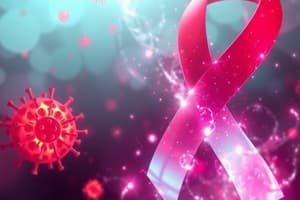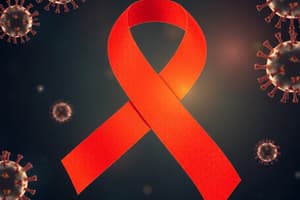Podcast
Questions and Answers
HIV primarily targets which type of immune cells, leading to immunodeficiency?
HIV primarily targets which type of immune cells, leading to immunodeficiency?
- CD4+ T cells (correct)
- Natural killer cells
- B cells
- CD8+ T cells
Which of the following is a critical step in the HIV replication cycle within a host cell?
Which of the following is a critical step in the HIV replication cycle within a host cell?
- Reverse transcription of viral RNA into proviral DNA. (correct)
- Replication of viral DNA using host cell DNA polymerase.
- Translation of viral proteins directly from the host cell's ribosomes.
- Direct integration of viral RNA into the host DNA.
What is the significance of the gp120 protein in the context of HIV infection?
What is the significance of the gp120 protein in the context of HIV infection?
- It is a structural protein that forms the viral capsid.
- It is an enzyme that integrates viral DNA into the host cell genome.
- It is responsible for the reverse transcription of viral RNA.
- It mediates the attachment of HIV to CD4 receptors and co-receptors on host cells. (correct)
During the acute phase of HIV infection, what immunological event primarily contributes to the initial control of viral load?
During the acute phase of HIV infection, what immunological event primarily contributes to the initial control of viral load?
A patient with HIV progresses to AIDS when their CD4+ T-cell count falls below what value?
A patient with HIV progresses to AIDS when their CD4+ T-cell count falls below what value?
Why is HIV prone to developing different viral strains within an infected individual?
Why is HIV prone to developing different viral strains within an infected individual?
What is the primary mechanism of action of antiretroviral therapy (ART) in treating HIV infection?
What is the primary mechanism of action of antiretroviral therapy (ART) in treating HIV infection?
Which of the following HIV diagnostic tests is recommended as the initial screening test due to its ability to detect early infection?
Which of the following HIV diagnostic tests is recommended as the initial screening test due to its ability to detect early infection?
What is the significance of CCR5 in the context of HIV infection, and how do mutations in this gene affect disease progression?
What is the significance of CCR5 in the context of HIV infection, and how do mutations in this gene affect disease progression?
During HIV infection, the switch from the R5 strain to the X4 strain is associated with what change in cellular tropism and disease progression?
During HIV infection, the switch from the R5 strain to the X4 strain is associated with what change in cellular tropism and disease progression?
Flashcards
What is HIV?
What is HIV?
Virus that targets immune cells, leading to immunodeficiency and increased risk of infections and tumors.
HIV-1 vs. HIV-2
HIV-1 vs. HIV-2
HIV-1 is more common globally and in the US, and more commonly associated with AIDS. HIV-2 is rarer and mainly found in western Africa and southern Asia.
How does HIV attach to cells?
How does HIV attach to cells?
HIV attaches to the CD4 molecule via the gp120 protein, also requiring binding to a co-receptor (CXCR4 or CCR5) to enter the cell.
What are HIV's main cell targets?
What are HIV's main cell targets?
Signup and view all the flashcards
HIV replication process
HIV replication process
Signup and view all the flashcards
What is viral tropism?
What is viral tropism?
Signup and view all the flashcards
Acute HIV infection
Acute HIV infection
Signup and view all the flashcards
Chronic HIV infection
Chronic HIV infection
Signup and view all the flashcards
When does HIV progress to AIDS?
When does HIV progress to AIDS?
Signup and view all the flashcards
Common HIV transmission routes
Common HIV transmission routes
Signup and view all the flashcards
Study Notes
The provided text is identical to the existing notes, so no updates are needed.
Studying That Suits You
Use AI to generate personalized quizzes and flashcards to suit your learning preferences.




